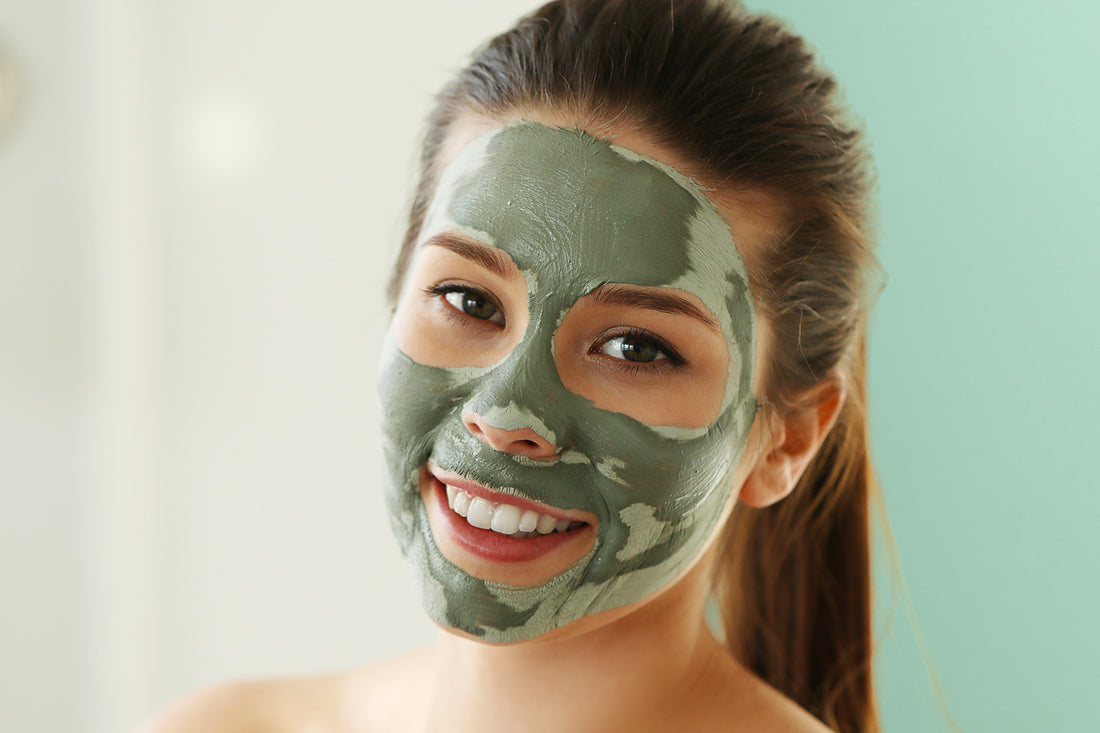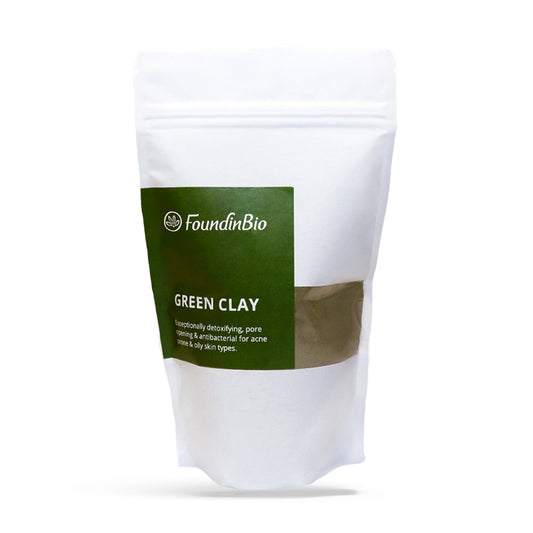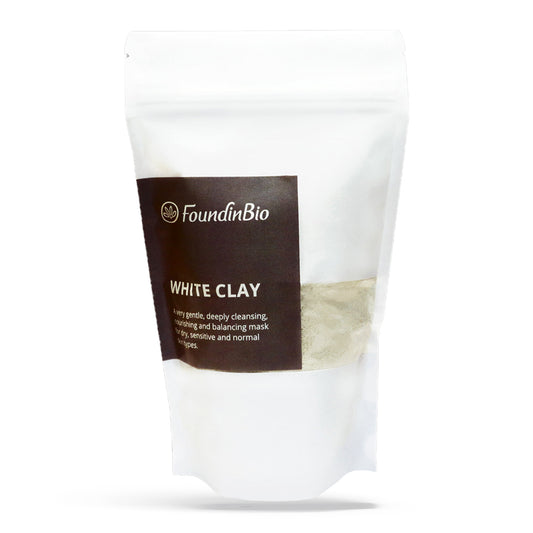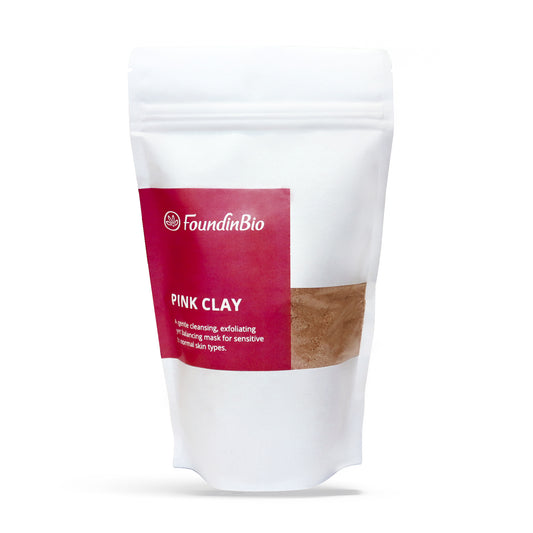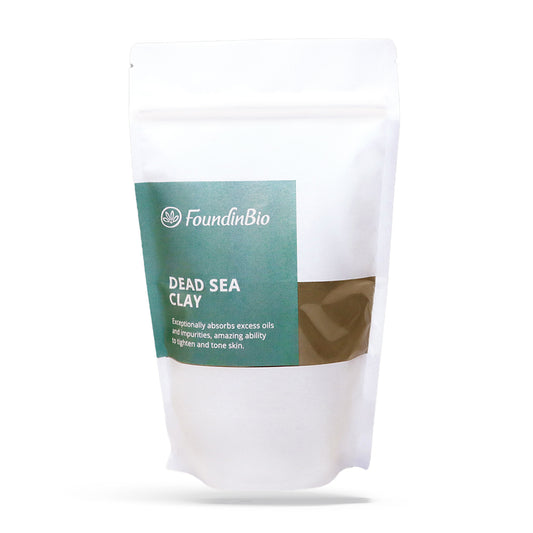Green clay combines iron oxides and decomposed matter, including algae or chlorophyll. In addition to the components that give green clay its color, it contains many other minerals, such as magnesium, calcium, potassium, manganese, phosphorus, silicon, zinc, cobalt, copper, and selenium.
Ideal for oily, combination, and acne-prone skin, Green clay is excellent for restoring balance to the skin. This powerful clay absorbs excess oil that can clog pores and lead to acne and blemishes and works as a powerful, deep cleansing agent that helps balance the skin's pH levels. As a bonus, Green clay stimulates cell regeneration, leaving the skin glowing.
A study published in 2008(1) proved that green clay could inhibit and eliminate bacterial growth. In addition, the mineral absorption properties of green clay are well-documented in healing skin and gastrointestinal diseases. Moreover, green clay can provide a cost-effective treatment for skin problems such as acne due to its antibacterial properties.
Green Clay Benefits
Green clay, also known as Montmorillonite clay, has been used as a natural cosmetic for centuries due to its unique physical and chemical properties. It is often applied as a face and body mask to absorb impurities and improve skin health. Using green clay as a skin treatment allows for a unique molecular exchange between the clay and the skin. When placed in contact with the skin, clay negatively charged with mineral salts attracts positive ions (debris and impurities), which are drawn away from the skin and replaced with the minerals in the clay.
But being a natural product with multiple uses in beauty, it has numerous applications and results. For example, raw green clay's properties can enrich the skin and body. Using green clay as part of your skincare routine can help balance oily, acne-prone skin, detoxify impurities, and improve skin tone and texture.

Green Clay Topical Benefits
Cleanses and decongests the skin.
It is a natural exfoliant and stimulant that works as a toner to reduce pores. Regular use can rebalance, smooth, and brighten the skin, improving its overall appearance. Because green clay impregnates the skin with beneficial organic minerals, all skin types can benefit. Furthermore, green clay's absorbent and detoxifying properties make it especially suitable for oily or blemish-prone skin.
It balances the skin and reduces imperfections.
Among its most widely known benefits is its ability to eliminate impurities from pores, exfoliate dead skin cells, tone and firm the skin, stimulate circulation and eliminate blemishes. In addition, its antibacterial properties help treat acne and blackheads, further enhancing skin rejuvenation, accelerating the creation of new cells, and reducing scarring.
Green clay combats cellulite and fluid retention.
Combating the uncomfortable cellulite in some areas of our body is another strength of this powerful clay. Montmorillonite clay helps reduce cellulite and eliminate fluid retention and the uncomfortable extra centimeters, thanks to its high mineral and detoxifying content.
It soothes and disinfects.
Green clay also has immense medicinal benefits. It heals and soothes cuts, scrapes, minor burns, insect bites, and sore muscles.
Green Clay Internal Benefits
Clay is one of the most versatile and economical natural products on the market. Revered by many ancient and indigenous cultures for its mineral content, consuming green clay is a natural and easy way to clean the bowels. But, more importantly, clay helps the body to gently and effectively eliminate chemicals, heavy metals, toxins, parasites, and bacteria.
We are now more aware of the chemicals, harmful toxins, and pesticides we are exposed to daily. As a result, we read labels, buy fresh and organic produce, drink filtered water, and avoid plastics. However, even for the most conscious consumer, it is almost impossible to avoid all these toxins altogether.

Although our bodies have a remarkable innate ability to efficiently eliminate many of the toxins to which we are exposed, the problem arises when the ingestion of toxins is faster than their elimination, resulting in a buildup of chemicals and toxins and can lead to toxic overload.
Common symptoms of toxic overload include aches, unexplained fatigue, muscle tension, mental confusion, lack of concentration, joint stiffness, bloating and flatulence, acidity, and reflux.
Green clay is a powerful and effective detoxifying agent, promoting the elimination of heavy metals, pesticides, chemicals, and other toxins from the body, supported by research(2) that showed that drinking clay was highly effective in eliminating salmonella, E.Coli, and methicillin-resistant Staphylococcus Aureus (MRSA), bacteria known to be responsible for several hard-to-treat infections in humans.
By eliminating these toxins daily as they pass through the digestive tract, clay can effectively treat health problems such as allergies, constipation, diarrhea, eczema, psoriasis and acne, anemia, arthritis, stress-related symptoms, and chronic infections.
How can I use green clay in my beauty routine?
Montmorillonite clay is commonly used in facial and hair masks, body wraps, medicinal poultices, in making natural soaps for the body and intimate areas. It can also be consumed with water first thing in the morning.
How many times a week can I use montmorillonite clay on my skin?
Due to its purifying effect, clay is a must-have for acne-prone, oily, combination, or dull skin. However, since it works very well in extracting oil, it should be used up to three times a week on oily skin. In the case of drier skin but very impure or with imperfections, use it at most once a week.

How long should I leave a green clay mask?
Contrary to popular belief, a clay mask should be left until it almost completely dries on the skin because it's when the clay absorbs more impurities from the pores and excess oil.
The belief that a clay mask will also absorb all moisture from the skin, drying it out even more, needs to be revised. Logically, the mask will absorb some moisture, sebum, impurities, and dead skin cells, but nothing that a subsequent moisturizing does not immediately resolve.
The duration of the green clay on the skin may vary depending on the thickness of the layers you apply. So the idea is to prepare the mask until you get a consistent and homogeneous paste, not too watery and not too thick, that starts to dry 10 to 15 minutes after application on the skin, and 10 to 20 minutes on the hair, because clay goes through 3 phases when applied.
- Wet Phase. The first phase, or wet phase, is when the clay performs nourishment and passes its minerals to our skin.
- Cooling and Exfoliation Phase. The second phase, or cooling and exfoliation phase, is when the clay begins to repel the skin a little and starts to dry out, producing the absorption effects, which help remove dead skin cells, and accelerate the renewal process, healing, and even skin tone. At this stage, the clay particles absorb excess sebum and remove impurities from the skin, being this the proper phase to remove the clay.
- Dry Phase. The third, or dry phase, is when clay becomes completely dry and crumbly, producing more extreme effects of absorption and exchange of fluids from inside to outside that draw water from the skin and can over-dry or irritate more sensitive skin. Again, avoid withdrawing at this stage if you have sensitive skin. If it happens, hydrate the skin well and ingest water throughout the day to rebalance the skin's water levels.

Green Clay Facial Mask
Ingredients
Foundinbio green clay: 3 teaspoons.
Mineral water q.b.
Natural oil: a few drops (almond, argan, or jojoba oil that is great for acne).
Preparation
- Put 3 teaspoons of clay in a glass bowl. Depending on the area you want to cover, you can put more clay (neck and cleavage).
- Add the mineral water and stir well until it forms a homogeneous paste, not too liquid or thick. Since green clay is an ultra-fine powder, add the water gradually and mix until you get a smooth homogeneous paste.
- Add a few drops of oil of your choice for a moisturizing effect. One of the benefits of applying a green clay mask to the face is to balance the natural oil (sebum) that the skin produces. Adding a few drops of almond, jojoba, or argan oil will moisturize and leave the skin soft.
- Apply the mask with a brush or fingers on clean skin without makeup. If you apply your mask with your fingers, it is essential to have thoroughly washed hands. Always avoid the area around the eyes and lips.
- Leave the mask on for 10 to 15 minutes, and do not touch your face, nose, or eyes.
- Remove the mask gently, with water at room temperature if your skin is more oily or with warm water if your skin is dehydrated, as warm water helps to stimulate the skin's natural oiliness.
- Moisturize with a natural organic cream or oil or your moisturizer of choice.
- Smile!
The health benefits of montmorillonite green clay are extraordinary. It is blissful to our bodies due to its high mineral content and absorbent properties. Always choose a high quality, 100% Natural, and Pollution Free, food grade, versatile, and multifunctional green clay. Green clay will indeed cleanse and regenerate your body from the inside out.
Sources:
(1) Chemical and Mineralogical Characteristics of French Green Clays for Healing. https://www.ncbi.nlm.nih.gov/pmc/articles/PMC2600539/
(2) Evaluation of the medicinal use of clay minerals as antibacterial agents. https://www.ncbi.nlm.nih.gov/pmc/articles/PMC2904249/

